|
|
| Разместил (Author): |
SergUA6  |
| Авторские права |
© http://www.radioscanner.ru |
|
|
Текст
|
Perspectives of the analysis of OFDM signals with CP.
As usual, we assume that reader possesses some basic knowledge concerning principles of formation OFDM, and the reader is acquainted with our previous articles, as terminology and the main ideas remain former.
There are some general provisions.
We already were being considered and showed in the previous articles, that at formation of OFDM signals the basic/main/key parameters are LS, LU and LG (CP), which are having dimensional samples. Basically, each one of these two parameters from these three (LS LU LG), unambiguously set the third parameter, as there is a simple correlation, namely:
LS = LU + LG;
We add one more, the dimensionless parameter, coefficient k = LG/LU or k = ((Sh/Br) - 1). This parameter allows to receive correct LS, LU and LG for specific conditions, besides k possesses mass of other remarkable properties, but it is beyond this article.
In a general view the scheme of formation of OFDM signal with CP looks as follows:
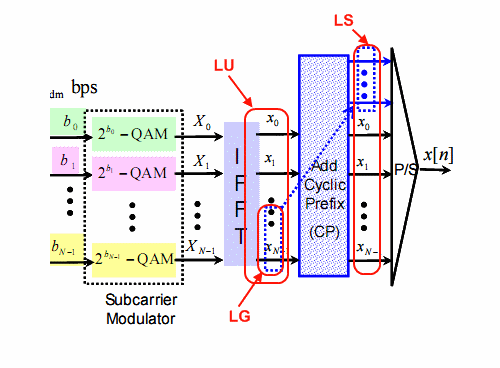
As we already considered, and I once again underline this moment, that there is no any Hertz and-or seconds! LS, LU and LG have at a stage of formation dimensionality of samples/samplings. We name it Fundamental/primary/key parameters of OFDM signal, these parameters are core of OFDM signal. All is equal to these parameters (samples), with what speed they will be transferred, needless to say, that transmission/transfer speed should be a constant.
As soon as some speed of following is given to samples (sampling rate of formation of OFDM signal OFDM), then earlier faceless values LS, LU and LG acquire/get dimensionality in Hertzs and-or seconds. But! They don't lose, and can't lose their main/fundamental properties. For example, as there was duration LS = 100, LU = 60 and LG (CP) = 40 samples, so it remains, irrespective of sampling rate.
There is one nuance in these transparent and logical enough conclusions. All what has been told above, concerns to so-called sampling rate of formation of OFDM signal.
In practice, to form a signal at once on operational frequency it is not convenient, and frequently it is not even possible. Normally, the signal should be formed on sampling rate Х, and further whole spectrum of the signal should be transferred on operational frequency Y. Thus, sampling rate X can't change duration LS, LU and LG, as it (sampling rate) is a consequence of existence of these parameters, and frequency of transfer Y can't destructively influence these parameters as it is not connected to them.
Let's sum up the told.
X is the conditional/formal parameter, and serves generally, for simplification of transfer of the signal on operational frequency Y. Х and Y don't influence on initial parameters LS, LU and LG. Moreover, neither Х, nor Y, can't change these parameters because, don't participate in their formation, and X&Y are secondary/external factors for LS, LU and LG. I will notice, that modulation type in the channels of OFDM signal also concerns to secondary parameters.
Certainly it is possible to distort LS, LU and LG, by resampling the signal from sampling rate of formation X, on any another. Thus, precise initial ratios/proportions of the core most likely will be broken. But, if not to break conditions of the Nyquist-Shennon theorem, then it is always to restore initial parameters, as oversampling as the linear and secondary procedure for LS, LU and LG, can't affect them destructively, in sense to destroy them irrevocably.
If the exterior oversampling can distort the true values LS, LU and LG, hence, in the same way, it can to recover them! This output not demanding special substantiations, nevertheless it is rather important, for one simple reason.
Above we said that X is formal/secondary parameter and doesn't influence OFDM core, as it is a consequence, instead of the reason of formation of the signal. Moreover, sampling rate X can be replaced/is changed/is distorted with other sampling rate, and it doesn't influence possibilities of recovery/obtaining of parameters of the core. Hence, generally, to us it is equally what is specific value sampling rate of a specific signal. It has no influence on the task of obtaining of the core parameters, and sampling rate will be selected/changed on such one, which will give exact initial parameters LS, LU and LG in samples.
Certainly, in normal life, such invariancy of signals OFDM isn't essential/demanded enough. The tasks are more prosaic and specific, the reliable communication is necessary, entrance in communication should be whenever possible fast, and quality as much as possible high. And side A, communicating with side B perfectly knows, what parameters of the signals, what LS, LU and LG, what sampling rate X they have. Expensive enough and exact/precise equipment optimized under specific values and decisions of specific tasks is used, such equipment guaranteed supporting those or other parameters of the signals.
The situation radically changes, when there is a C side. The side C doesn't know anything about the signal, but it very much wants to get information about the signal, moreover, side C wishes to have the same demodulator as well as sides A-B. It is impossible to solve this task to the C side, without obtaining of the main characteristics of the signal. :)
The main characteristics for OFDM, as it has been shown above, are LS, LU and LG. We are going a bit further, and we reduce the primary goal of the analysis of OFDM signals to obtaining of coefficient k, as to more common decision.
Obtaining of secondary parameters, such as type of signal’s model, modulation in the channels etc can’t be guaranteed without obtaining of authentic/reliable parameters of OFDM core. Parameters of the core, don't depend on exterior conditions, and have dimensionality of samples. Values, which are gotten in samples LS, LU and LG is possible to lead/bring to any values in Hertzs and-or seconds. Hz or seconds it doesn't play a special role, and we do not put it as the purpose of the analysis of OFDM signals. It is good if all coincides with in advance known values. But there is also no tragedy if it doesn't coincide, especially because of the fact that it is not a problem to adjust it to the necessary values. LS, LU and LG as a result of the analysis should coincide with original values anyway, otherwise the analysis as itself hasn't taken a place.
There are actually all general provisions/points. The detailed substantiations and the researches, wishing ones can lead independently. :)
Below, we will consider how does all this works on practice, on the real signals, on the signals about which we don't know anything, except the fact of their presence. We will consider examples with usage SA of version 6.2.4.6
Example
A row of already standard actions.
1. Selection of a necessary/interesting part of the signal by V-markers.
2. OFDM module call/launch, the program start on searches CT.
3. Function "ADP" invocation - Auto Define Params.
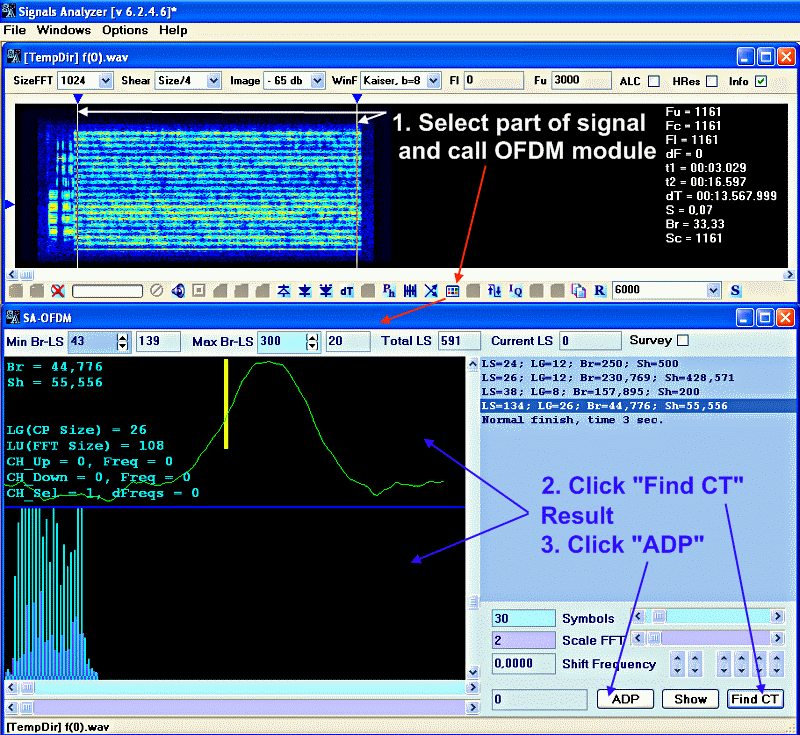
Pay attention - step 2: the program finds the triangle very quickly, and automatically positions/locates it in an optimal position. There is no sense to be delayed as the following mandatory step, is invocation of function ADP, earlier this function was called "GetBr".
Also pay attention that now the triangle is always positive, and at the expense of it its sizes are increased on/by a vertical. As there is no sense in the negative triangle it simply isn't displayed.
We with pleasure would eliminate this pause after step 2, having caused function "ADP" automatically, if not one but. There are no 100 percentage warranties that the program has found CT correctly. Yes, in hundred cases from hundred, the program finds the correct triangle, but the probability of an error exists, and it is not the zero chance. Thus, acceptance of the finite decision is laid to the person, to continue or replace parameters and to repeat search.
Tasks of "ADP" function: Control/check of current value/condition of CT, and if it is necessary its full recalculation. Obtaining/calculation concerning exact value of clock frequency of manipulation. Signal Offset/positioning/replacement on/by frequency.
In this version an accuracy of obtaining of a clock frequency is higher, but it is necessary to mark, that the previous versions also provided hight accuracy, and improving is not radical, it is rather cosmetic effect, but nevertheless.
Concerning the signal positioning on/by frequency. The error can easily reach the tenth portions/part of percent from frequency of a spacing of the channels. For example for the signal with the frequency spacing of channels at 50-80 Hertz, positioning error can be to + / - 0.5-0.8 Hertzs. It is a big value, we temporarily leave the decision of this problem for the second plan.
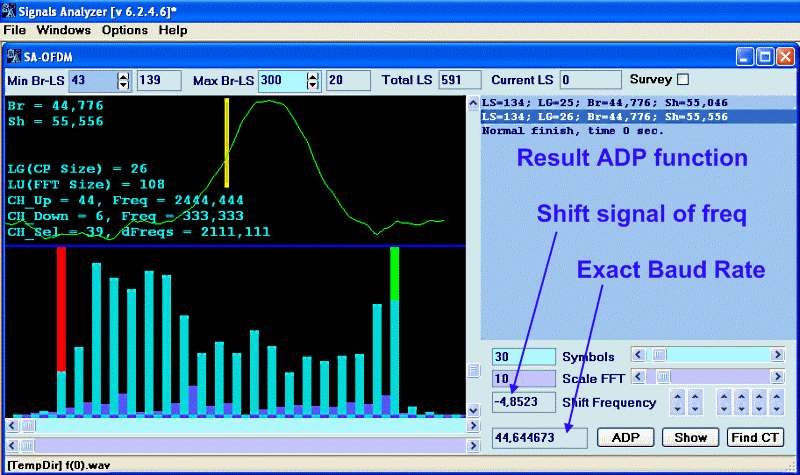
If to look at values of the clock frequency of manipulation and the frequency of a spacing of channels, then we gain stable enough opinion that this signal at its basis has parameters of the well-known signal MIL-188-110B-39 tone, which has standardized values Br = 44.4 (4) Hz, and Sh = 56.25 Hz. As, for this signal are known both LU = 128 and LG = 34, then the temptation simply is greatest to "adjust" an analysable signal to these values, and to declare their as the result of the analysis. Probably it also will turn out as the correct result, but to speak about objectivity and accuracy of this result, in that case hardly costs. It is fully incorrect approach to analysis OFDM.
Above we said that sampling rate of a signal X can be strongly distorted and even to be roughly incorrect, but it should not be reflected in obtaining of the correct values LS, LU and LG. And that’s why it is not necessary to give a special value to values in Hertzs and-or in seconds. As finally, sampling rate X is selected from the necessity, which depends on current conditions. There is nothing which can prevent to re-sample/oversample the signal on the correct frequency for current conditions X.
The coefficient k for this signal is equal 1/4. I won't result screenshots of program OCG, it is easier to result the correct values LU and LG. They are equal accordingly 108 and 27 samples. The correct value of frequency of sampling rate X for the analysis/demodulation of this signal is equally (108 (LU) + 27 (LG)) *44,644673 (Br) ~ 6027 Hz.
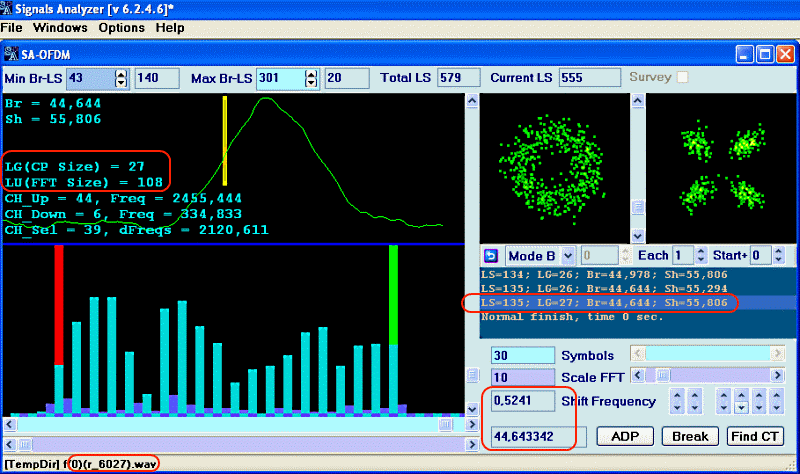
Actually k = ¼ assumes usage of very wide number of the correct values LU and LG. We are selected the nearest values to the ones, which had been gotten beforehand.
Pay attention to small difference in measured values Br, before oversampling, it is normal.
Other signal
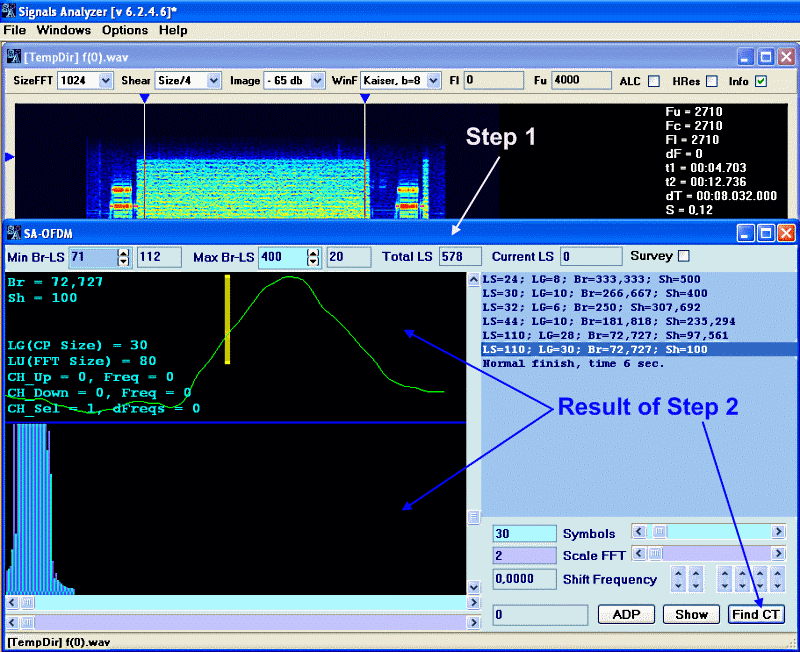
I hope it is noticeably that the algorithm of CT determination works very quickly, and displays much lesser "trash".
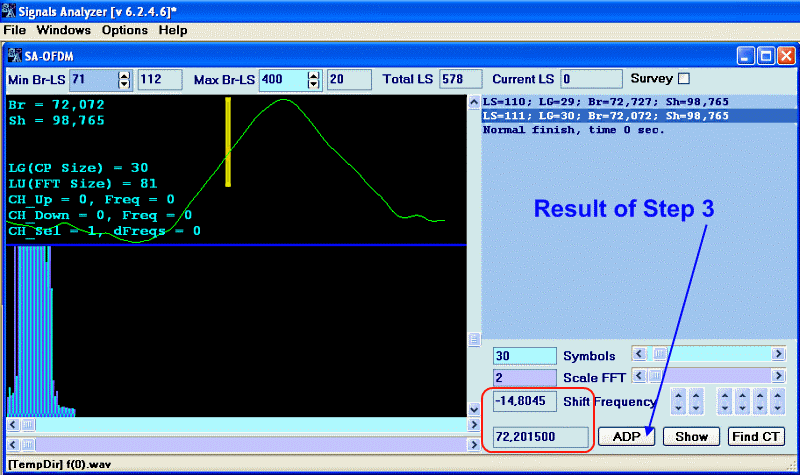
Function "ADP" also works faster and more precisely.
Value of coefficient k for this signal is equal 3/8, that allows to receive all what is necessary.
LU = 80
LG = 30
The correct sampling rate for the analysis/demodulation is ~ 7942 Hertzs.
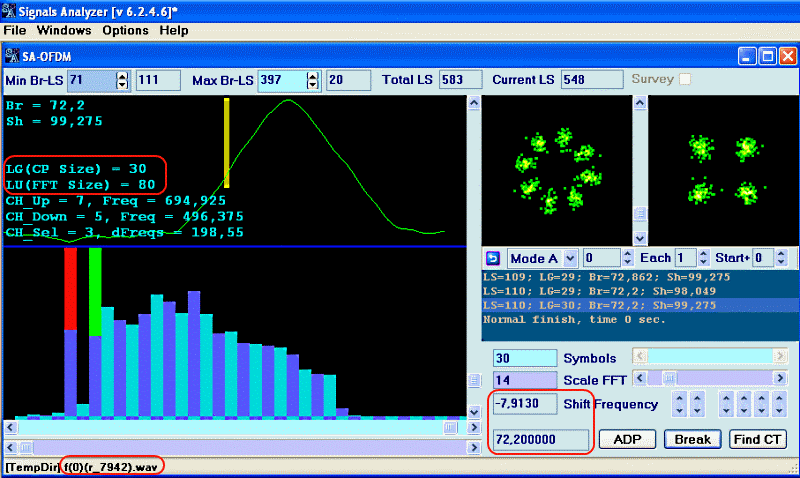
It is not difficult to note that analysis OFDM in the current version is simplified a little bit, but without essential changes in the whole.
Some words in summary/conclusion.
In this article, once again, we have tried to justify the positions under the analysis of OFDM signals, through calculation/getting "Magic K". We don't insist that it is only the one true and faultless approach, but at least, it is absolutely working variant, and to our command it seems rather perspective. At least, "Magic K" has been received by us practically for all OFDM signals, what are located in the base of signals of the site http://www.radioscanner.ru
Once again, for the reader the appearing out of nowhere coefficient k looks strange enough. We already had been spoken, that we have insider decisions and if nothing will prevent to our plans, we are planning to realize an integration of "the calculator k" in SA in the next 30-60 days. Now there are intensive checks, statistics data collection, algorithm optimization etc.
Also it is not necessary to perceive an article, especially the first part, as the full substantiation of our ideas. It is only a descriptive part of peak of an iceberg, under a title "the Analysis of signals OFDM with CP". :)
Good Luck~
|
|
|
|
Добавлять комментарии могут только зарегистрированные, активировавшие регистрацию и не ограниченные в доступе участники сайта!
|
| Файл создан: 27 Apr 2011 21:35, посл. исправление: 29 Apr 2011 20:46 |
|

